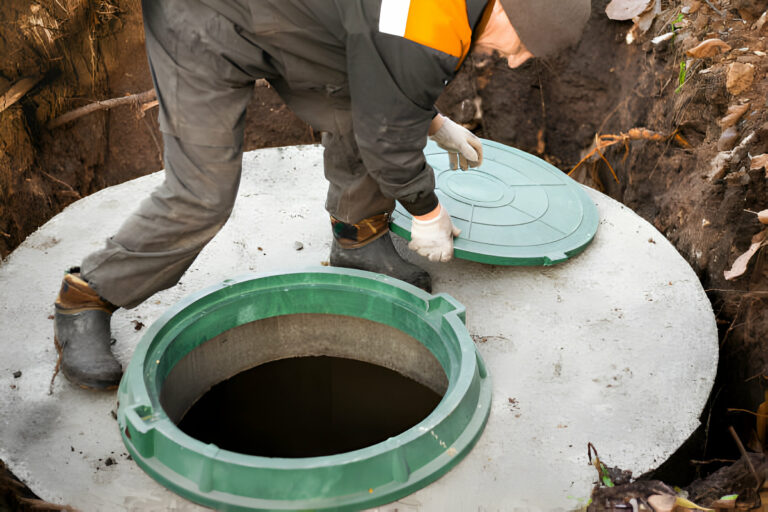Have you decided to switch from sewer to septic systems? Although it’s a good consideration, there are some questions to ask before your septic tank installation. This article covers every aspect you should consider before switching to septic systems. Let’s find out these questions to make an informed decision.

What Size Septic Tank Do I Need?
When installing a septic tank, it is important to answer the first basic question: What size septic tank do I need? While there is no “one-size-fits-all” solution to this, there are still ways to determine the ideal septic tank size for your home.
One way to do this is by actually measuring the amount of water your family uses every day. You can do this by checking your well meter daily if you’ve one or by installing a new meter.
Check your meter every day at the same time and note the reading to find out your household’s water usage each day. For optimum results, do this for at least a week or preferably for a month. Analyze the readings and determine your home’s average daily water usage.
According to Michigan State University, your goal is to install a tank double the size of your daily wastewater. Simply put, the ideal septic tank should hold two day’s amount of wastewater.
However, if you’re not interested in measuring your daily water usage or you don’t have regular usage, you can always estimate. Most professionals recommended having a minimum 1000-gallon septic tank for 2 or 3-bedroom home use. Moreover, it is suggested that a 250-gallon septic tank be added for every bedroom over 3 bedrooms.
|
Number of Bedrooms |
Minimum Septic Tank Size |
|
2 or less |
1000 – 1500 Gallons |
|
3 |
1000 – 2000 Gallons |
|
4 |
1250 – 2500 Gallons |
|
5 |
1500 – 3000 Gallons |
|
6 |
1750 – 3500 Gallons |
(Note: Septic tank size recommendations may vary depending on so many factors, including where you reside, your local government rules and regulations, soil type, the size of your home, and your anticipated wastewater usage.)
Additionally, you can check minimum liquid surface area from the State of New York and drainfield recommendations by the State of Michigan.
How Often Should You Service Your Septic System?
Regular servicing of your septic system is vital to ensure its optimal performance and longevity. Determining how often you should service your septic tank depends on various factors tailored to your household’s needs.
Typically, septic tanks require pumping every two to five years, with yearly maintenance recommended for aerobic treatment unit (ATU) tanks, especially in rural areas. However, the precise frequency varies based on several key considerations.
Firstly, the type of septic tank you have significantly influences the maintenance schedule. Conventional tanks generally need pumping less frequently than ATU tanks due to their different mechanisms for waste breakdown.
Additionally, the size of your septic tank and household plays a crucial role. Larger tanks and households generate more waste, necessitating more frequent servicing. For instance, a family of four may need to pump a 1,000-gallon tank every two and a half years, while a 2,000-gallon tank might require pumping every five years.
Moreover, your water usage habits impact septic tank maintenance. Efficient water use can prolong the system’s lifespan by reducing strain and preventing issues like leaks and backups.
(Also Read: My Septic Tank Backing Up After Being Pumped: What Should I Do?)
To ensure your septic system operates smoothly, consult with a premium septic pump professional to determine how often you should service your septic system.

How Long Does It Take to Install a Septic System?
The overall time required for installing a septic system typically ranges from 4 to 8 weeks. This encompasses various stages, including
- Site evaluation and design
- Permitting
- Excavation and installation
- Inspection
- Backfilling with land restoration
The initial phase involves assessing soil conditions and designing the system, followed by the permitting process, which can vary based on local regulations. The physical installation, including excavating and placing the septic tank and leach field, may take 1-2 weeks, depending on system size and complexity. Inspection times are subject to local scheduling, and the final phase involves backfilling and restoring the site.
It’s important to note that these timelines are general estimates. There is no single answer to how long it takes to install a septic system. Actual durations can be influenced by factors such as site-specific conditions, regulatory processes, and the efficiency of the installation team.
Working with experienced professionals and adhering to local guidelines ensures a smooth and timely septic system installation.
What is the Cost of Installing a Septic System?
The cost of installing a septic tank ranges from $3,600 to $10,000. There are also some additional costs to consider. These include:
- Percolation test
- Land survey
- Permits
- Tank size
- Labor
Apart from that, the cost of installation also depends on the type of system as well. Conventional systems cost as low as $2,500, whereas complex design systems could cost as much as $20,000 at the higher end. Here is the comparison of costs according to the types of septic systems:
Type of Septic System | Cost |
Conventional | $2,500 – $9,000 |
Anaerobic | $2,500 – $6,500 |
Alternative septic system | $4,000 – $15,000 |
Engineered | $10,000 – $20,000 |
Can Failing Septic Systems Affect Human Health?
Yes, failing septic systems can have significant implications for human health and the surrounding environment. When a septic system fails, it may result in the release of untreated wastewater containing harmful pathogens and contaminants into the soil and water sources. Here are some ways in which failing septic systems can impact human health:
Water Contamination: Untreated sewage from a failing septic system can contaminate nearby groundwater and surface water. This contamination may introduce bacteria, viruses, and other pathogens into drinking water sources, posing a risk of waterborne diseases to humans.
Airborne Contaminants: In some cases, failing septic systems can lead to the release of foul odors and potentially harmful gasses into the air. These gasses may include methane and hydrogen sulfide, which can cause respiratory issues and other health problems.
Soil Contamination: The untreated effluent from a failing septic system can contaminate the soil with harmful bacteria and chemicals. This contamination may pose a risk to individuals who come into direct contact with the contaminated soil, especially if it is used for gardening or other activities.
To mitigate these health risks and ensure eco-friendly septic systems, it’s crucial to address septic system issues promptly through repairs, maintenance, or replacement. Regular inspections, proper system maintenance, and adherence to local regulations are essential to prevent septic system failures and protect human health and the environment.
What Maintenance Is Required for the Septic System?
If maintained properly septic systems can last an eternity. We’ve gathered some key maintenance tasks to follow in order to keep your septic systems running healthy and functional for as long as possible:
Regular Pumping: Schedule septic tank pumping every 2-5 years, determined by factors like tank size, household occupancy, and waste type.
Leak Inspection: Regularly walk around your septic system, especially during pumping, checking for lush grass or strong odors indicating leaks. Inspect baffles during pump-outs to ensure they’re intact.
Protect the Leach Field: Clearly mark the leach field to prevent damage from heavy loads. Manage plant growth, removing trees and bushes to avoid root intrusion into pipes.
Limit Water Usage: Divert roof water away from the leach field, install water-saving appliances, fix leaks promptly, and space out water-intensive activities like laundry.
Mind What Goes Down the Drain: Proper disposal of fats and food waste and the use of septic-safe cleaners help maintain a healthy bacterial balance in the tank.
Bacteria Additives: Introduce bacteria additives to support the breakdown of unnatural substances, protecting the septic system from harm caused by powerful cleaning solutions.
Effluent Filter Installation: Enhance leach field life by installing an effluent filter during septic tank pumping. Cleaning is required every 3-5 years to maintain effectiveness.
Check for Leach Field Clogs: During wet weather, monitor for signs of a clogged leach field, such as sewage smells, rapid grass growth, slow drains, or standing water.
Maintain Accurate Records: Keep detailed records of all maintenance activities and inspection results to guide future maintenance and provide valuable information for potential home buyers.
DIY vs. Hiring a Professional
Unless you’ve experience in the field, it’s wise to leave it to the professionals. It’ll save you from unexpected failures and costs in the long run.
To avoid potentially costly mistakes by doing it yourself, you can always leave your septic system problems to us. Call at 860-949-0108 or click here to schedule your appointment now!


